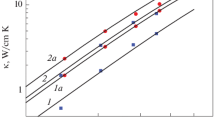Abstract
The effect of anisotropy of elastic energy on the electron–phonon drag and thermoelectric phenomena in potassium crystals at low temperatures is investigated in this work. The standard theory of deformation potential is used for longitudinal components of elastic modes. The effect of shear waves on the drag thermoelectric power is taken into account. By comparing the results of calculating the thermoelectric power and lattice thermal conductivity with experimental data, the electron–phonon interaction constant for the shear components of vibrational modes is determined. It is an order of magnitude smaller than for the longitudinal components. It is shown that shear waves make a significant contribution to both the electron–phonon relaxation and the drag thermoelectric power. This contribution is from 28 to 40% of the total drag thermoelectric power for various samples and is four to six times higher than the contribution from longitudinal phonons.


Similar content being viewed by others
REFERENCES
I. I. Kuleev and I. G. Kuleev, “Phonon focusing and anisotropy of the lattice thermal conductivity of potassium crystals at low temperatures,” Phys. Met. Metallogr. 119, 1141–1147 (2018).
I. I. Kuleev and I. G. Kuleev, “Role of quasi-longitudinal and quasi-transverse phonons in the drag thermopower of potassium crystals at low temperatures,” J. Exp. Theor. Phys. 129, 46–58 (2019).
I. I. Kuleev and I. G. Kuleev,” Drag thermopower in nanowires and bulk potassium crystals under the conditions of competition between the boundary and bulk mechanisms of phonon relaxation,” J. Phys.: Condens. Matter 31, 375701(13 pp) (2019).
I. I. Kuleev and I. G. Kuleev, “Effect of anisotropy of elastic energy on the electron–phonon drag and temperature dependences of thermal emf in potassium crystals at low temperatures,” Phys. Met. Metallogr. 120, 1033–1039 (2019).
I. G. Kuleev, I. I. Kuleev, S. M. Bakharev, and V. V. Ustinov, Focusing of Phonons and Phonon Transport in Single Crystal Nanostructures, (Izdatel’stvo UMTs UPI, Yekaterinburg, 2018) [in Russian].
D. K. C. MacDonald, W. B. Pearson and I. M. Templeton, “Thermo-electricity at low temperatures. VIII. Thermo-electricity of the alkali metals below 2 K,” Proc. R. Soc. London, Ser. A 256, 334–358 (1960).
A. M. Guenault and D. K. C. MacDonald, “Electron and phonon scattering thermoelectricity in potassium and alloys at very low temperatures,” Proc. R. Soc. London, Ser. A 264, 41–59 (1961).
M. R. Stinson, R. Fletcher, and C. R. Leavens, “Thermomagnetic and thermoelectric properties of potassium,” Phys. Rev. B 20, 3970–3990 (1979).
R. Fletcher, “Scattering of phonons by dislocations in potassium,” Phys. Rev. B 36, 3042–3051 (1987).
F. J. Blatt, P. A. Schroeder, C. L. Foiles, and D. Greig, Thermoelectric Power of Metals (Plenum press, New York, 1976), p. 264.
J. M. Ziman, Electrons and Phonons. The Theory of Transport Phenomena in Solids (Oxford, 2001).
F. J. Blatt, Physics of Electronic Conduction in Solids (McGraw-Hill, 1968).
J. M. Zyman, “The thermoelectric power of the alkali metals at low temperatures,” Philos. Mag. 4, 371–379 (1959).
C. Herring and E. Vogt, “Transport and deformation-potential theory for many-valley semiconductors with anisotropic scattering,” Phys. Rev. 101, 944–961 (1956).
P. Yu. M. Kardona, Fundamentals of Physics of Semiconductors (Fizmatlit, Moscow, 2002) [in Russian].
F. I. Fedorov, Theory of Elastic Waves in Crystals (Nauka, Moscow, 1965).
I. G. Kuleev and I. I. Kuleev, “Elastic waves in cubic crystals with positive or negative anisotropy of second-order elastic moduli,” Phys. Solid State 49, no. 3, 437–444 (2007).
B. Truel, C. Elbaum, and B. B. Chick, Ultrasonic Methods in Solid State Physics (Academic Press, New York, 1969), p. 307.
L. E. Gurevich, “Thermoelectric properties of semiconductors. I,” Zh. Eksp. Teor. Fiz. 16, 193 (1946).
C. Herring, “Theory of the thermoelectric power of semiconductors,” Phys. Rev. 96, 1163 (1954).
L. E. Gurevich and I. Ya. Korenblit, Influence of electron dragging by phonons and their mutual dragging on the kinetic coefficients of semimetals,” Fiz. Tverd. Tela 6, 856–863 (1964).
J. W. Ekin and B. W. Maxfield, “Electrical resistivity of potassium from 1 to 25 K,” Phys. Rev. B 4, 4215–4225 (1971).
Funding
This work was carried out within a state assignment from the Ministry of Education and Science of the Russian Federation (topic “Function”, no. AAAA-A19-119012990095-0).
Author information
Authors and Affiliations
Corresponding author
Additional information
Translated by E. Chernokozhin
Rights and permissions
About this article
Cite this article
Kuleev, I.I., Kuleev, I.G. The Role of Shear Waves in Electron–Phonon Drag in Potassium Crystals at Low Temperatures. Phys. Metals Metallogr. 121, 921–928 (2020). https://doi.org/10.1134/S0031918X20100063
Received:
Revised:
Accepted:
Published:
Issue Date:
DOI: https://doi.org/10.1134/S0031918X20100063




